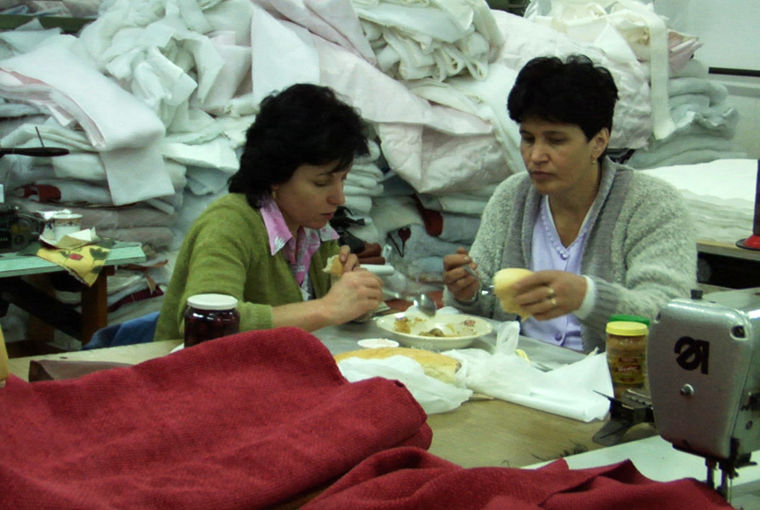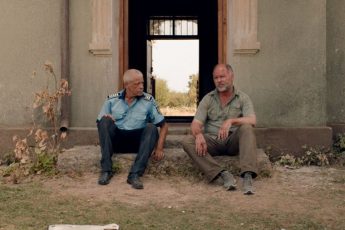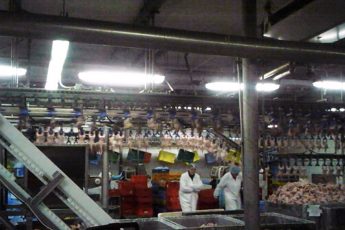The Social Life of Objects and the Dismantling of the Socialist City
Ana Vlad’s and Adi Voicu’s Metrobranding (2010) and Victoria (2010)
Vol. 12 (December 2011) by Alina Popescu
A love story between men and objects is the surprising title of a documentary film directed by two young Romanians directors: Ana Vlad and Adi Voicu. Starting from the objects found in their homes, they had the original idea to question the destiny of some successful brands from the Communist time. Among these glorious objects we can count the sewing machine called Ileana, the Pegas bike, the Mobra motorcycle, the light bulb made at Fieni, the Relaxa mattress and the sneakers from Dragasani. The majority of these objects, which shaped the communist consumer’s imaginary, did not have the chance of a second youth after 1989. While the other ones are subsisting only in people’s memory or in the storing rooms of those who cannot let them go, the only success story which still continues in the present is the Relaxa mattress. What do they mean today for those who made them, and what is their career in a competitive economy? How did they end up being solid communist brands? What can an object reveal about the past and the present? Is the story we see a local one, or does it have a larger geography? These are just a few of the questions this film is discussing.
Metrobranding is a documentary which privileges observation and is built around a few people and the objects they gave life to. But it is also a film about cities whose glory was connected to a product and about the life of working-class people. The film gives us the opportunity to roam around theses towns and their factories. In one episode, we have the chance to see women at work while assembling the Relaxa mattress. Today, the people whose lives were connected to the manufacturing of these objects are talking about them with emotion – be it humor or regret. At Fieni, an old man is reading poetic and philosophical annotations about light before testing the quality of a light bulb. The Pegas bike is being tested by an adult who weighs 120 kg, thus confirming the resistance of a children’s bike (“this is the German system!”), and the Dragasani sneakers are tried on by a boy who plays football, as well as by a young athlete.
An entire mythology which traveled time revolved around these objects. The idea – be it veracious or not-, that they are objects meant to last for a lifetime, is referred to nostalgically by those who lived back then. These objects were difficult to get into Romanians’ houses (they were especially meant for export). It is doubtless that these objects have a personal rhetoric. Some of them gave birth to folkloric idioms. A lot of people remember jokes such as: “if you want to please your wife buy a Relaxa for life”, or another one about trying to assemble a sewing machine and fetching a machine gun. Ironically, the factory where Ileana used to be manufactured still exists today, but is making guns now. Mobra and Pegas used to be manufactured in the same place where they used to make anti-marine mines.
But how did these standardized objects turn into unique and highly valuable products? The film is able to show how these objects were having a specific social life, extending the world of factories to private space. After watching this film, many Romanians will remember the odyssey they underwent to obtain one of these objects. The value of these objects was not only a purely material one, of immediate utility, but also a symbolic, social and affective one. Multiple social interactions would revolve around them, services would be bought, exchanges made, they would go through the hand of generations. The happy owner would get a note of distinction and would be above the others: “you had to be someone of importance to have an Ileana sewing machine,” says someone in the movie.
It wouldn’t be surprising if upon viewing such a film, some people would desire to have, maybe not a Ileana sewing machines, but certainly a Dragasani pair of sneakers, “1001, for the export”. Despite some predictable nostalgic effects and humorous accents, the film remains interrogative in tone, overshadowing the ridicule or involuntary naivety of some characters and situations. The footage is punctual, the interventions of the filmmakers are discreet and well-placed, the characters are endearing, and each object is revealed on the screen in a unique mise en scène.
The second film Victoria is about a Romanian city by the same name. Victoria was the first city constructed during Romanian’s People Republic, built around a chemical industry. Today, the industry is gone and Victoria is a ghost town. As many other towns with no tradition, condemned to forgetfulness after the disappearance of industrial activity justifying their presence on the map, Victoria has difficulties finding a new identity. The name itself, “Victory City”, is anachronic. Losing the chance to become a touristic site in the 90s, the city lives in between its communist past and the neo-liberal present. Thus, in a school whose walls are carrying traces of social realism, children are being sold American books on how to think big and succeed in life. At the “Casa de Cultura” (Culture House), in a scene which is reminiscent of 12.08 East of Bucharest, a teacher speaks to a bored audience about the difference between a people and a population, about the history and philosophy of science, the beauty of the Romanian language, and about Romanian rights and the European destiny. Beyond the humor of these contrasts, the unemployment, the pollution, the young people’s emigration, and the lack of perspective seem to be constant problems of these inhabitants. If at the beginning of the documentary, an insert from the “Scanteia” newspaper tells us that the silence from the city is due to the working hours, we understand that today’s silence is caused by the fact that people’s social life is limited to their private space. Victoria is a ghost city.
Devoted to an observational approach, the filmmakers are grasping the way in which a city is being explored by following some characters in their everyday activities and immersing themselves in a few specific institutions (school, firefighter department, casa de cultura, restaurant). The filmmaker’s choice not to overload the images with commentaries, statistics and archival information can only be admired. By immersing into those places and by building close relationships with the characters on screen, the two filmmakers tell a captivating story which makes us reflect upon our own relationship with objects, places and people from the present and past. Both films have the merit of bringing two themes to attention that, until now, were intensely ideological in Communism: the city and the activity of the working-class.




Leave a Comment